You are using an out of date browser. It may not display this or other websites correctly.
You should upgrade or use an alternative browser.
You should upgrade or use an alternative browser.
Butterfly garden advice
- Thread starter Francesca
- Start date
- Joined
- Jan 5, 2017
- Messages
- 1,517
- Reaction score
- 1,345
- Location
- Atlantic Beach, Fl
- Hardiness Zone
- 9a
- Country

For the best butterfly gardens that attract and keep butterflies around you need Host Plants. For determining the type of host plants, you first have to identify they type of butterflies in your area.
Milkweed is the obvious for monarchs and a couple other species, but for other host plants you need to do a little research.
I heavily mulch my yard and I get some weeds, but many weeds are actually host plants; my latest weed to make it to my yard is the False Nettle which is a host plant for at least three species of butterflies.
Here's one list of host plants https://www.thebutterflysite.com/create-butterfly-garden.shtml
As for simple nectar plants, most all pollinators love things in the Mint and Asteraceae family, but there are many others... https://en.wikipedia.org/wiki/Asteraceae
Milkweed is the obvious for monarchs and a couple other species, but for other host plants you need to do a little research.
I heavily mulch my yard and I get some weeds, but many weeds are actually host plants; my latest weed to make it to my yard is the False Nettle which is a host plant for at least three species of butterflies.
Here's one list of host plants https://www.thebutterflysite.com/create-butterfly-garden.shtml
As for simple nectar plants, most all pollinators love things in the Mint and Asteraceae family, but there are many others... https://en.wikipedia.org/wiki/Asteraceae
JBtheExplorer
Native Gardener
I'm starting a butterfly garden and am in way over my head! Can anyone help me? I live in zone 5 and the garden will be in a very sunny spot. I'm looking for low maintenance but colorful flowers.
Native plants are what you want. Natives are maintenance-free and work perfectly with the butterflies that are native to your location. There are all kinds of great native plants that will attract tons of butterflies, and while I don't know which plants are native to you, here are some that work best for me and should work great for you:
Butterflyweed is a member of the milkweed family. It's bright orange and attracts all sorts of butterflies. it's also the host plant for Monarchs. You can also plant Swamp Milkweed, which is taller and has bright pink flowers. Sometimes you'll find tons of caterpillars on milkweed.
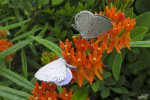
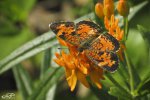
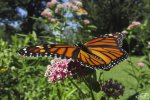
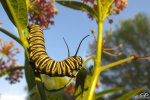
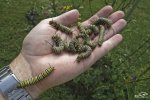
Blue Giant Hyssop is one of the best pollinator magnets I have. It's generally short lived but super easy to grow and spreads by reseeding. Butterflies, hummingbirds, hummingbird moths, and even an endangered bumble bee has been seen on mine. As a bonus, goldfinches love the seeds in autumn.
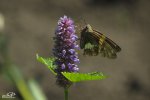
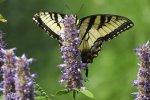
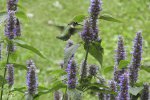
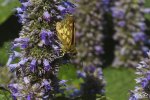
Purple Coneflower is probably the number one plant you have to have in a butterfly garden to attract a wide variety of butterflies. They have a lot of hybrids/cultivars out there, but the true native specie works best.
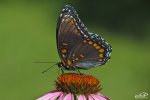
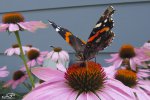
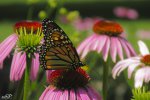
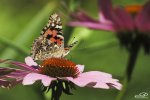
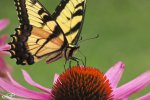
Joe Pye Weed is most enjoyed by Monarchs, Swallowtails, and Red-spotted Purples.
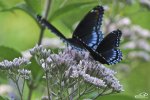
Hoary Vervain is a short-lived but fast growing native, as well as a heavy self-seeder. I tend to see various Skipper butterflies on it more than anything else, but hummingbirds have been attracted to it here and there.
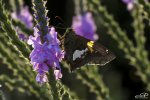
Rattlesnake Master tends to attract Spring Azures and Red Admirals in my garden.
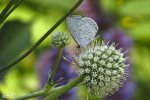
It's not as widely known as it should be, but the number one nectar source for Monarch butterflies is Meadow Blazing Star (Liatris ligulistylis). Other plants don't attract nearly as many, including other Blazing Stars. For some reason, they really love this specific specie. If you have the time, look at some of the videos of this plant on youtube. You'll see what I mean.
Lastly, while it's not native, it's worth having if you have the room. Mexican Sunflower attracts tons of butterflies and hummingbirds, and can really help the monarchs and hummingbirds during autumn migration. It's an annual that grows really easy in dry sunny areas, but it gets big. Most seed packets say 4'-6' tall, but I've never had them that short. They always get 8' to 9' tall in my yard. I plant a row of them along my fence, and tie them up to the fence so the rain doesn't tip them over and rip them out of the ground.
- Joined
- Nov 2, 2020
- Messages
- 8
- Reaction score
- 11
- Country

Greetings, welcome to the Forums.
Butterfly Gardening in Three Easy Steps, of decreasing importance.
1. Don't use most insecticides Neither broad-spectrum chemicals nor 'organic' Bacillus thuringiensis (B.t.), both are highly toxic to butterflies. Yes, this is the most important thing you can do, because even without planting particular plants, you will still get some butterflies on common ornamentals and weeds, even skippers (Hesperiidae) on your lawn grass.
...but if you poison them you will get nothing.
2. The Right Plants: Plant both the correct larval food plants and a variety of nectar plants to feed adults throughout the seasons.
3. Abiotic amenities Shelter from strong wind and spots of damp mud to let butterfliies siphon minerals in solution will be much appreciated by these 'flying flowers' of the insect world.
Butterfly Gardening in Three Easy Steps, of decreasing importance.
1. Don't use most insecticides Neither broad-spectrum chemicals nor 'organic' Bacillus thuringiensis (B.t.), both are highly toxic to butterflies. Yes, this is the most important thing you can do, because even without planting particular plants, you will still get some butterflies on common ornamentals and weeds, even skippers (Hesperiidae) on your lawn grass.
...but if you poison them you will get nothing.
2. The Right Plants: Plant both the correct larval food plants and a variety of nectar plants to feed adults throughout the seasons.
3. Abiotic amenities Shelter from strong wind and spots of damp mud to let butterfliies siphon minerals in solution will be much appreciated by these 'flying flowers' of the insect world.
- Joined
- Feb 13, 2021
- Messages
- 3,433
- Reaction score
- 2,148
- Country

Good point Marck, the plants caterpillars feed on and those butterflies visit for nectar are not always the same. I have a corner at the back of the garden that is brambles and stinging nettles, you may not have them in the US, but they are both food plants for a number of our caterpillars, and not at all attractive. In the main flower bed are Verbena Bonariensis, blue and white Buddlias and Michaelmas Daisy, all of which attract butterflies seeking nectar.
A word on buddlia, I dead head them thoroughly and chop them down to size each year. They will grow huge so you can't reach the dead flowers and produce seed that grows in any gutter, crack or crevice, causing overflows, tearing down walls and doing a lot of damage, I read somewhere that British Rail alone spends several million pounds each year getting rid of them.
A word on buddlia, I dead head them thoroughly and chop them down to size each year. They will grow huge so you can't reach the dead flowers and produce seed that grows in any gutter, crack or crevice, causing overflows, tearing down walls and doing a lot of damage, I read somewhere that British Rail alone spends several million pounds each year getting rid of them.
Ask a Question
Want to reply to this thread or ask your own question?
You'll need to choose a username for the site, which only take a couple of moments. After that, you can post your question and our members will help you out.
Similar Threads
Forum statistics
Latest Threads
-
Aucuba Plant
- Started by big rockpile
-
Tool sharpening
- Started by frank synek
-
Tomato seedlings problems
- Started by JustJuju
-
Clover lawn: how to establish
- Started by Gardenoid
-
Allium transplant root shock advice ...
- Started by Gardenoid
-
Iris ?
- Started by big rockpile
-
Apps.
- Started by Mark83
-
Poinsettia only getting morning sun now...
- Started by abrogard
-
What's Looking Good in May 2024
- Started by zigs
-
Not sure were to post this
- Started by TheRealGrower
